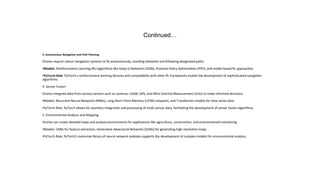Python - Deep Learning library-PyTorch.pptx
- 1. PyTorch PyTorch is an open-source deep learning framework developed by Facebook's AI Research lab (FAIR). It is widely used in the machine learning and deep learning communities for its flexibility, ease of use, and strong support for dynamic computational graphs. Here are some key features and aspects of PyTorch.
- 2. PyTorch in autopilot sysyems PyTorch is widely utilized in autopilot systems for developing and deploying various machine learning models. It is an essential tool in the development of autopilot systems, enabling the creation, training, and deployment of complex machine learning models that are crucial for autonomous driving functionalities. Here’s how PyTorch is typically used in autopilot systems: 1. Object Detection and Classification Autonomous vehicles must detect and classify objects such as other vehicles, pedestrians, road signs, and obstacles. Models: Convolutional Neural Networks (CNNs) and advanced architectures like YOLO (You Only PyTorch Role: PyTorch’s extensive library support and easy-to-use APIs facilitate the development and training of these models.
- 3. Continued… 2. Semantic Segmentation Semantic segmentation helps in understanding the environment by segmenting an image into different classes like road, sidewalk, buildings, etc. •Models: U-Net, SegNet, DeepLab. •PyTorch Role: PyTorch’s dynamic computation graph and extensive support for custom layers and loss functions make it ideal for developing segmentation models. 3. Path Planning and Control •Path planning involves determining the optimal path for the vehicle to follow, while control systems handle the execution of this path. Models: Reinforcement Learning (RL) algorithms like Deep Q-Networks (DQN), Proximal Policy Optimization (PPO). PyTorch Role: PyTorch supports RL libraries such as stable-baselines3 which can be integrated with PyTorch to develop path planning and control algorithms.
- 4. Continued… 4. Sensor Fusion Autonomous vehicles rely on multiple sensors like cameras, LiDAR, radar, and ultrasonic sensors. Sensor fusion involves combining data from these sensors to get a comprehensive understanding of the environment. Models: Recurrent Neural Networks (RNNs), Long Short-Term Memory (LSTM) networks, and custom architectures. PyTorch Role: PyTorch’s flexibility allows for the integration of various data modalities and the development of complex architectures needed for effective sensor fusion. 6. Simulation and Testing Before deploying in real-world scenarios, models are extensively tested and validated in simulated environments. •Tools: Simulation environments like CARLA, AirSim. •PyTorch Role: PyTorch models can be easily integrated with these simulation environments for testing and validation.
- 5. PyTorch is increasingly used in drone systems for a variety of tasks ranging from navigation and control to object detection and environmental analysis. Here are some key areas where PyTorch plays a role in drone systems: PyTorch is a powerful tool in the development of drone systems, enabling the creation, training, and deployment of advanced machine learning models for various tasks. Its flexibility, ease of use, and extensive library support make it a preferred choice for researchers and developers working on drone technology. 1. Object Detection and Tracking Drones often need to detect and track objects for applications such as surveillance, search and rescue, and package delivery. •Models: Convolutional Neural Networks (CNNs), YOLO (You Only Look Once), SSD (Single Shot Multibox Detector), Faster R-CNN. •PyTorch Role: PyTorch provides pre-trained models and the flexibility to fine-tune these models for specific tasks. 2. Semantic Segmentation Drones use semantic segmentation to understand the environment by categorizing each pixel in an image into classes such as buildings, trees, roads, and water bodies. •Models: U-Net, SegNet, DeepLab. •PyTorch Role: PyTorch’s dynamic computation graph and ease of defining custom loss functions and architectures make it ideal for developing segmentation models. PyTorch in drone systems
- 6. 3. Autonomous Navigation and Path Planning Drones require robust navigation systems to fly autonomously, avoiding obstacles and following designated paths. •Models: Reinforcement Learning (RL) algorithms like Deep Q-Networks (DQN), Proximal Policy Optimization (PPO), and model-based RL approaches. •PyTorch Role: PyTorch’s reinforcement learning libraries and compatibility with other RL frameworks enable the development of sophisticated navigation algorithms. 4. Sensor Fusion Drones integrate data from various sensors such as cameras, LiDAR, GPS, and IMUs (Inertial Measurement Units) to make informed decisions. •Models: Recurrent Neural Networks (RNNs), Long Short-Term Memory (LSTM) networks, and Transformer models for time-series data. •PyTorch Role: PyTorch allows for seamless integration and processing of multi-sensor data, facilitating the development of sensor fusion algorithms. 5. Environmental Analysis and Mapping Drones can create detailed maps and analyze environments for applications like agriculture, construction, and environmental monitoring. •Models: CNNs for feature extraction, Generative Adversarial Networks (GANs) for generating high-resolution maps. •PyTorch Role: PyTorch’s extensive library of neural network modules supports the development of complex models for environmental analysis. Continued…
- 7. 6. Simulation and Testing Simulating drone flights and testing algorithms in virtual environments are crucial for ensuring safety and reliability before real-world deployment. •Tools: Simulation environments like AirSim and Gazebo. •PyTorch Role: PyTorch models can be integrated with these simulation platforms to train and validate drone algorithms. Continued…
- 8. PyTorch is widely utilized in research across various domains due to its flexibility, ease of use, and comprehensive libraries. Here’s a detailed breakdown of how PyTorch is used in research: 1. Model Development and Prototyping •Dynamic Computation Graphs: PyTorch’s dynamic computation graphs (eager execution) allow researchers to modify network architectures on the fly, facilitating rapid experimentation and iteration. •Easy Debugging: Since computations in PyTorch are performed immediately, debugging is straightforward, making it easier to identify and fix issues during model development. Dynamic Computation Graphs in PyTorch In traditional deep learning frameworks, computation graphs are static. This means the entire computation graph must be defined before running the model, making it difficult to modify the architecture once the model is built. In contrast, PyTorch uses dynamic computation graphs, which are constructed on-the-fly as operations are executed. This is known as eager execution. Benefits of Dynamic Computation Graphs Ease of Debugging: Since computations are executed immediately, it is easier to debug models. Researchers can use standard Python debugging tools and print statements to inspect tensors and intermediate results at any point in the graph. PyTorch in research
- 9. Flexibility: •Dynamic computation graphs allow researchers to change the network architecture on-the-fly. This is particularly useful for experimenting with different model configurations and architectures without needing to redefine the entire graph. Improved Experimentation: •Researchers can rapidly prototype and test new ideas. The ability to modify the network during runtime means that new layers, connections, or architectural changes can be implemented and evaluated quickly. Immediate Feedback: •Since the model computations are executed immediately, researchers get immediate feedback on their changes. Advanced Neural Network Architectures in PyTorch PyTorch's flexibility and comprehensive library support make it an ideal framework for implementing a wide range of advanced neural network architectures. Researchers and developers can build anything from standard models to cutting-edge architectures, such as Generative Adversarial Networks (GANs), Transformers, and Graph Neural Networks (GNNs). Neural Network Architectures Neural network architectures refer to the design and structure of neural networks, which define how the artificial neurons (or nodes) in the network are arranged and connected. The architecture determines the network's ability to learn and perform tasks such as classification, regression, or generation. Key components of neural network architectures include the layers, the number of neurons in each layer, the activation functions, and the connectivity patterns between neurons. Benefits of Dynamic Computation Graphs Continued…








